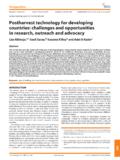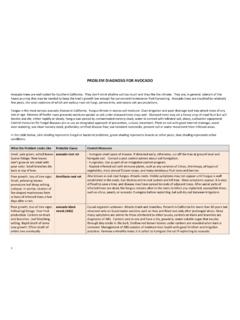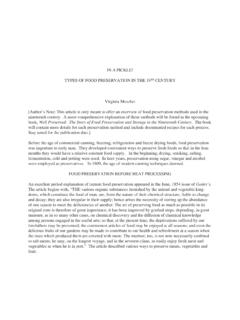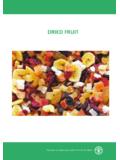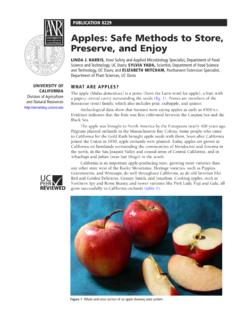Transcription of Nutritional comparison of fresh, frozen and canned fruits ...
1 Journal of the Science of Food and Agriculture J Sci Food Agric 87:930 944 (2007). Review Nutritional comparison of fresh, frozen and canned fruits and vegetables. Part 1. Vitamins C and B and phenolic compounds Joy C Rickman, Diane M Barrett and Christine M Bruhn . Department of Food Science and Technology, University of California Davis, Davis, CA 95616, USA. Abstract: The first of a two-part review of the recent and classical literature reveals that loss of nutrients in fresh products during storage and cooking may be more substantial than commonly perceived. Depending on the commodity, freezing and canning processes may preserve nutrient value. The initial thermal treatment of processed products can cause loss of water-soluble and oxygen-labile nutrients such as vitamin C and the B.
2 Vitamins. However, these nutrients are relatively stable during subsequent canned storage owing to the lack of oxygen. frozen products lose fewer nutrients initially because of the short heating time in blanching, but they lose more nutrients during storage owing to oxidation. Phenolic compounds are also water-soluble and oxygen- labile, but changes during processing, storage and cooking appear to be highly variable by commodity. Further studies would facilitate the understanding of the changes in these phytochemicals. Changes in moisture content during storage, cooking and processing can misrepresent changes in nutrient content. These findings indicate that exclusive recommendations of fresh produce ignore the nutrient benefits of canned and frozen products.
3 Nutritional comparison would be facilitated if future research would express nutrient data on a dry weight basis to account for changes in moisture. 2007 Society of Chemical Industry Keywords: nutrient; fruit ; vegetable ; canned ; frozen ; vitamins; phenolic INTRODUCTION can be consumed year round and transported safely fruits and vegetables are colourful, flavourful and to consumers all over the world, not only those nutritious components of our diets and are often located near the growing region. As a result of most attractive and health-promoting when harvested processing, respiration is arrested, thereby stopping at their peak maturity. Unfortunately, most people the consumption of nutritious components, the loss do not have home gardens capable of supplying the of moisture and the growth of micro-organisms.
4 The recommended 5 13 daily servings year round. Many first objective of fruit and vegetable processing is to fruits and vegetables grow only in certain parts of ensure a safe product, but processors also strive to the world, under specific temperature and humidity produce the highest-quality products. Depending on environments, and at particular times of the year. In how processing is carried out, it may result in changes addition, fruits and vegetables are typically over 90% in colour, texture, flavour and Nutritional quality, the water and, once they are harvested, begin to undergo last of which is the subject of the following literature higher rates of respiration, resulting in moisture loss, review.
5 Quality deterioration and potential microbial spoilage. A substantial amount of research literature has Harvesting itself separates the fruit or vegetable from been published over the past 75 years reporting the its source of nutrients, the plant or tree, and it effects of processing, storage and cooking on the essentially uses itself as a source of calories. Many Nutritional quality of fruits and vegetables. Washing, fresh fruits and vegetables have a shelf life of only days peeling and blanching steps prior to processing are before they are unsafe or undesirable for consumption. responsible for some loss of water-soluble nutrients. Storage and processing technologies have been However, the thermal processing often associated utilised for centuries to transform these perishable with canning and pre-freezing blanching treatments fruits and vegetables into safe, delicious and stable is especially detrimental to heat-sensitive nutrients products.
6 Refrigeration slows down the respiration of such as ascorbic acid (vitamin C) and When fruits and vegetables and allows for longer shelf lives. used prior to canning, blanching serves to expel air Freezing, canning and drying all serve to transform in the tissue and improve thermal conductivity and perishable fruits and vegetables into products that packing into the container. The primary purpose of . Correspondence to: Christine M Bruhn, Department of Food Science and Technology, University of California Davis, Davis, CA 95616, USA. E-mail: (Received 21 April 2006; revised version received 19 October 2006; accepted 1 December 2006). Published online 14 March 2007; DOI: 2007 Society of Chemical Industry.
7 J Sci Food Agric 0022 5142/2007/$ Nutritional comparison of fresh, frozen and canned fruits and vegetables blanching prior to freezing is to inactivate naturally fresh product. Researchers should simulate conditions occurring enzymes that may still be active in the on the known cultivars harvested from selected frozen product. Blanching is an important preservation locations. Nutritional qualities also vary according to step in the canning and freezing processing of many season and growing location, so individual results may vegetables. fruits , on the other hand, are usually not be representative of yearly averages or regional not blanched prior to freezing owing to their delicate availability. nature and inherent acidity.
8 Nutrients may also be lost Some researchers have approached these problems through oxidation, especially during heat treatment by examining the differences in fresh, frozen and and storage. Since both unprocessed and processed canned fruits and vegetables purchased at a retail fruits and vegetables must undergo some transport market. Although the cultivars are likely not consistent and storage, degradation of some nutrients prior to and the products have undergone different storage and consumption is expected. Lower temperatures, even processing conditions, these retail market studies offer in frozen goods, tend to prolong the shelf life of fruits a representation of the Nutritional differences between and Additional cooking of the processed fresh, frozen and canned products that are available to product can also destroy nutrients, although the extent consumers in that location.
9 Of degradation is dependent on cooking method, Besides variance in methodologies, changes in nutrient and commodity. In Part 1 we discuss vitamins Nutritional data may be reported on a dry weight (DW). C and B and phenolic compounds. Part 2 will look at or a wet weight (WW) basis. Moisture content often vitamin A and carotenoids, vitamin E, minerals and changes during processing, especially during canning with the addition of aqueous media. Furthermore, changes in moisture content due to weight loss Research approaches can occur during storage, the extent of which is The retention of ascorbic acid is often used as dependent on conditions such as relative humidity. an estimate for the overall nutrient retention of Measurements of changes in bioactive components food ,5 Ascorbic acid is by far the least on a wet weight basis may thus be misleading.
10 Stable nutrient during processing; it is highly sensitive Some researchers avoid this dilemma by comparing to oxidation and leaching into water-soluble media results on both bases or by adjusting their wet weight during processing, storage and cooking of fresh, products for content of soluble solids. However, many frozen and canned fruits and ,7 Other studies still report results only on a wet weight basis, vitamins, minerals and bioactive components are more complicating the interpretation of results. stable; high retention of certain components, such as vitamin E, is common during processing, storage and Nutritional guidelines cooking. Retention of nutrients is highly dependent on Despite possible degradation of nutrients during cultivar, production location, maturity stage, season processing, storage and cooking, fruits and vegetables and processing 14 are rich sources of many vitamins and minerals, as Despite the wealth of research published, under- well as fibre.



